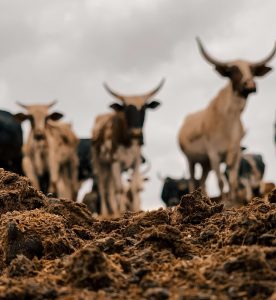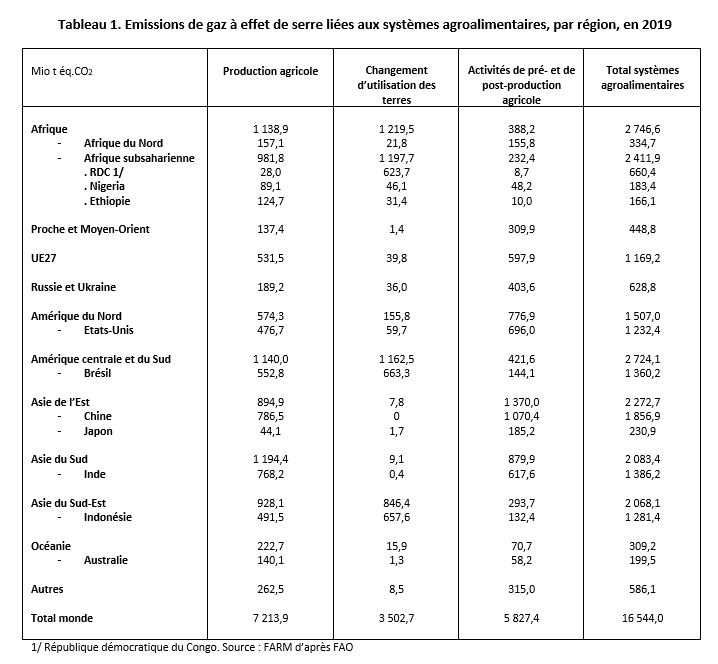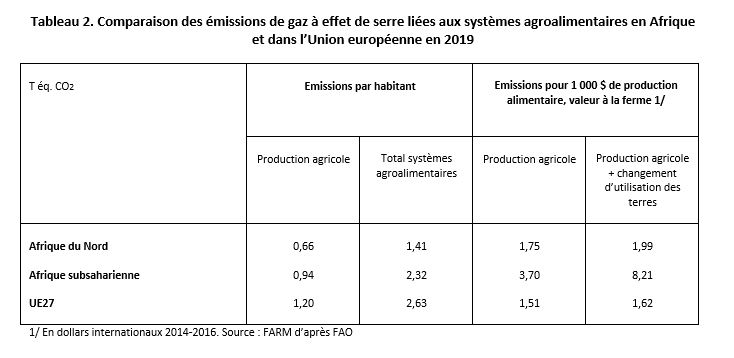The heavy climate footprint of African agriculture
Contrary to what intuition suggests, food systems in Africa emit significantly more greenhouse gases overall than those in Europe and the United States, due in part to low agricultural productivity and significant deforestation. Transforming African agricultural sectors to reduce their environmental footprint while ensuring the continent's food security is a major challenge.

On the occasion of the 26thth At the United Nations Climate Change Conference (COP26), held last November in Glasgow, the FAO published detailed statistics on greenhouse gas (GHG) emissions from agri-food systems.[1]The value of these figures is that they offer a comprehensive overview of the carbon footprint of the various links in the agri-food chain, from farm to fork, taking into account changes in land use due, for example, to deforestation caused by crop expansion. Anyone who delves into the data will come away with some key ideas on the challenges of climate change for African agricultural sectors.
First, and contrary to what intuition suggests, Africa was responsible, in 2019, for 17 % (15 % for sub-Saharan Africa and 2 % for North Africa) of global GHG emissions linked to agri-food systems, more than the United States (9 %) and the European Union (7 %) combined. (table 1). Its weight remains practically the same (16 %) if we consider only agricultural production, without taking into account upstream activities (fertilizer manufacturing) and downstream (processing, transport, distribution of foodstuffs), nor deforestation. It is therefore highly desirable, to effectively combat climate change, that the increase in agricultural production in Africa – imperative to feed a population that is doubling – is based on production systems that are relatively low in fossil energy consumption and capable of storing more carbon in the soil. This is a formidable challenge if we consider that the use of mineral fertilizers in this region remains on average well below the global average and that large parts of agriculture are still poorly mechanized.

Secondly, and this partly explains the previous observation, the carbon footprint of African agri-food systems, relative to population and food production, is heavy. Certainly, in sub-Saharan Africa, these systems emit, per capita, slightly less GHG (2.3 tonnes of CO2 equivalent) than in the European Union (2.6). (table 2). But per capita food production is also much lower, which partly explains the subregion's food insecurity. As a proportion of the value of food production, the quantities of GHGs south of the Sahara are more than twice as high as in the EU27. They are even five times higher if land use change is taken into account. In Africa, in fact, particularly in the Congo Basin, deforestation and the cultivation of pastures release into the atmosphere quantities of CO2 twice as high as those of nitrous oxide and methane released by cultivated soils and livestock. Hence the challenge of improving agricultural productivity on the continent, which is necessary for agricultural production to grow faster than input consumption and for farmers to be less inclined to expand the surface area of their farms to the detriment of grass and forest, even if this is not the only cause of deforestation.

These overall figures mask considerable geographic diversity. Central Africa is responsible for 35 billion 300 million of greenhouse gas emissions linked to the continent's food systems, ahead of West Africa, with 28 billion 300 million. North Africa accounts for only 12 billion 300 million of the total. Of the 51 African countries listed by the FAO, 10 emit more than 60 billion 300 million of GHGs linked to agricultural production. Ethiopia leads the way (11 billion 300 million), followed by Nigeria (8 billion 300 million). Similarly, the Democratic Republic of Congo alone accounts for more than half of the emissions due to land-use change and nearly a quarter of all GHG emissions linked to food systems in Africa.
The fact remains that these data are edifying. They argue for ecological intensification of African agriculture, making it possible to address the joint challenges of climate change and biodiversity protection, while improving farmers' incomes and creating jobs in the upstream and downstream sectors of the agricultural sector. To drive this change, appropriate public policies, with substantial budgets and sustained long-term implementation, must be put in place. Given the imperative of an ecological transition, it would be incomprehensible if food systems were left behind in the transformation of the continent's economies.
Un commentaire sur “La lourde empreinte climatique des agricultures africaines”
Leave a Reply
You must be logged in to post a comment.

This article raises many questions that deserve to be analyzed more closely.
These questions indeed deserve to be asked and the solutions proposed could be more concrete.
In my opinion, and given the current configuration of agricultural policies in Africa, the executive systems are unable to meet these challenges. And the situation is continuing to worsen.
As an African entrepreneur, I believe that another path favoring direct North-South and South-South private partnerships will be more effective.
This perspective is essential and many agricultural companies like ours are already prepared to do so.